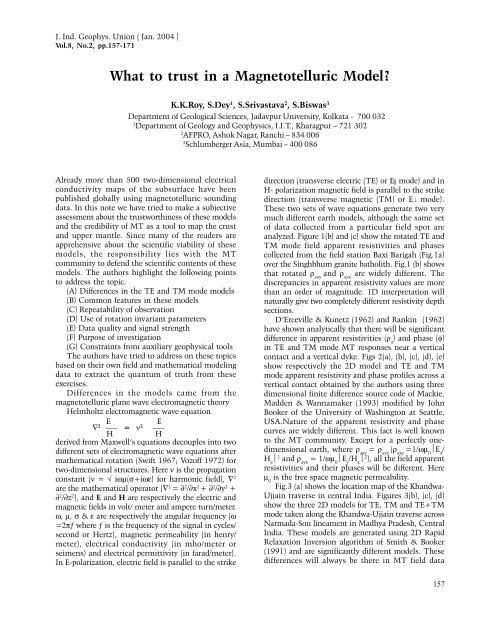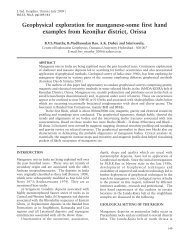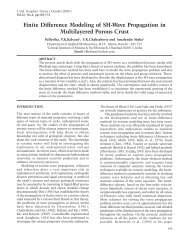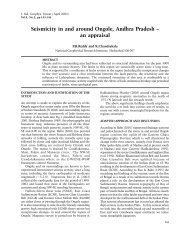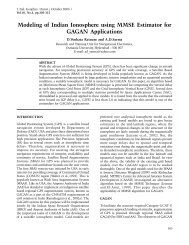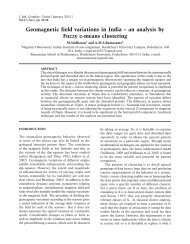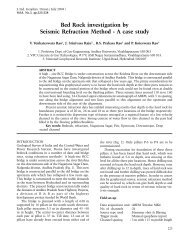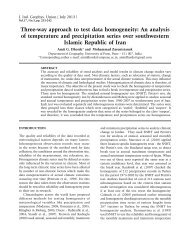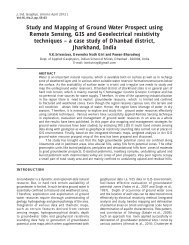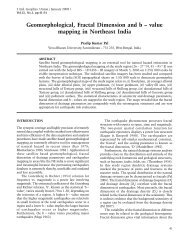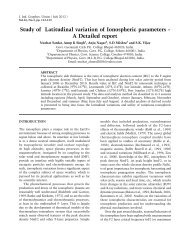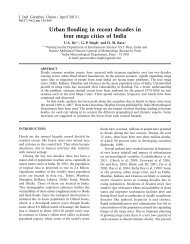What to trust in a Magnetotelluric Model? - IGU
What to trust in a Magnetotelluric Model? - IGU
What to trust in a Magnetotelluric Model? - IGU
Create successful ePaper yourself
Turn your PDF publications into a flip-book with our unique Google optimized e-Paper software.
J. Ind. Geophys. Union ( Jan. 2004 )Vol.8, No.2, pp.157-171<strong>What</strong> <strong>to</strong> <strong>trust</strong> <strong>in</strong> a Magne<strong>to</strong>telluric <strong>Model</strong>?K.K.Roy, S.Dey 1 , S.Srivastava 2 , S.Biswas 3Department of Geological Sciences, Jadavpur University, Kolkata - 700 0321Department of Geology and Geophysics, I.I.T., Kharagpur – 721 3022AFPRO, Ashok Nagar, Ranchi – 834 0063Schlumberger Asia, Mumbai – 400 086Already more than 500 two-dimensional electricalconductivity maps of the subsurface have beenpublished globally us<strong>in</strong>g magne<strong>to</strong>telluric sound<strong>in</strong>gdata. In this note we have tried <strong>to</strong> make a subjectiveassessment about the <strong>trust</strong>worth<strong>in</strong>ess of these modelsand the credibility of MT as a <strong>to</strong>ol <strong>to</strong> map the crustand upper mantle. S<strong>in</strong>ce many of the readers areapprehensive about the scientific viability of thesemodels, the responsibility lies with the MTcommunity <strong>to</strong> defend the scientific contents of thesemodels. The authors highlight the follow<strong>in</strong>g po<strong>in</strong>ts<strong>to</strong> address the <strong>to</strong>pic.(A) Differences <strong>in</strong> the TE and TM mode models(B) Common features <strong>in</strong> these models(C) Repeatability of observation(D) Use of rotation <strong>in</strong>variant parameters(E) Data quality and signal strength(F) Purpose of <strong>in</strong>vestigation(G) Constra<strong>in</strong>ts from auxiliary geophysical <strong>to</strong>olsThe authors have tried <strong>to</strong> address on these <strong>to</strong>picsbased on their own field and mathematical model<strong>in</strong>gdata <strong>to</strong> extract the quantum of truth from theseexercises.Differences <strong>in</strong> the models came from themagne<strong>to</strong>telluric plane wave electromagnetic theoryHelmholtz electromagnetic wave equationE E∇ 2 _____ = ν 2 _____HHderived from Maxwell’s equations decouples <strong>in</strong><strong>to</strong> twodifferent sets of electromagnetic wave equations aftermathematical rotation (Swift 1967; Vozoff 1972) fortwo-dimensional structures. Here ν is the propagationconstant (ν = √ iωµ(σ+iωε) for harmonic field), ∇ 2are the mathematical opera<strong>to</strong>r (∇ 2 = ∂ 2 /∂x 2 + ∂ 2 /∂y 2 +∂ 2 /∂z 2 ), and E and H are respectively the electric andmagnetic fields <strong>in</strong> volt/ meter and ampere turn/meter.ω, µ, σ & ε are respectively the angular frequency (ω=2πƒ where ƒ is the frequency of the signal <strong>in</strong> cycles/second or Hertz), magnetic permeability (<strong>in</strong> henry/meter), electrical conductivity (<strong>in</strong> mho/meter orseimens) and electrical permittivity (<strong>in</strong> farad/meter).In E-polarization, electric field is parallel <strong>to</strong> the strikedirection (transverse electric (TE) or E|| mode) and <strong>in</strong>H- polarization magnetic field is parallel <strong>to</strong> the strikedirection (transverse magnetic (TM) or E⊥ mode).These two sets of wave equations generate two verymuch different earth models, although the same se<strong>to</strong>f data collected from a particular field spot areanalyzed. Figure 1(b) and (c) show the rotated TE andTM mode field apparent resistivities and phasescollected from the field station Baxi Barigah (Fig.1a)over the S<strong>in</strong>ghbhum granite batholith. Fig.1 (b) showsthat rotated ρ axyand ρ ayxare widely different. Thediscrepancies <strong>in</strong> apparent resistivity values are morethan an order of magnitude. 1D <strong>in</strong>terpretation willnaturally give two completely different resistivity depthsections.D’Erceville & Kunetz (1962) and Rank<strong>in</strong> (1962)have shown analytically that there will be significantdifference <strong>in</strong> apparent resistivities (ρ a) and phase (φ)<strong>in</strong> TE and TM mode MT responses near a verticalcontact and a vertical dyke. Figs 2(a), (b), (c), (d), (e)show respectively the 2D model and TE and TMmode apparent resistivity and phase profiles across avertical contact obta<strong>in</strong>ed by the authors us<strong>in</strong>g threedimensional f<strong>in</strong>ite difference source code of Mackie,Madden & Wannamaker (1993) modified by JohnBooker of the University of Wash<strong>in</strong>g<strong>to</strong>n at Seattle,USA.Nature of the apparent resistivity and phasecurves are widely different. This fact is well known<strong>to</strong> the MT community. Except for a perfectly onedimensionalearth, where ρ axy= ρ ayx(ρ axy=1/ωµ 0⏐E x/H y⏐ 2 and ρ ayx= 1/ωµ 0⏐E y/H x⏐ 2 ), all the field apparentresistivities and their phases will be different. Hereµ 0is the free space magnetic permeability.Fig.3 (a) shows the location map of the Khandwa-Ujja<strong>in</strong> traverse <strong>in</strong> central India. Figures 3(b), (c), (d)show the three 2D models for TE, TM and TE+TMmode taken along the Khandwa-Ujja<strong>in</strong> traverse acrossNarmada-Son l<strong>in</strong>eament <strong>in</strong> Madhya Pradesh, CentralIndia. These models are generated us<strong>in</strong>g 2D RapidRelaxation Inversion algorithm of Smith & Booker(1991) and are significantly different models. Thesedifferences will always be there <strong>in</strong> MT field data157
K.K.Roy et al.Figure 1. (a) Shows the location of the MT site Baxi Barigah <strong>in</strong> North-South Keonjhargarh profile, eastern India,(b) and (c) are respectively the magne<strong>to</strong>telluric rotated TE and TM mode apparent resistivities and phases; apparentresistivity curves are show<strong>in</strong>g more than an order of magnitude difference.158
<strong>What</strong> <strong>to</strong> <strong>trust</strong> <strong>in</strong> a Magne<strong>to</strong>telluric <strong>Model</strong>?Figure 2 (a). Shows an earth model hav<strong>in</strong>g the vertical contact EFHG parallel <strong>to</strong> the y-direction, the block ADFEILHGis hav<strong>in</strong>g resistivity of 1 ohm-m., the block EBCFGJKH is hav<strong>in</strong>g resistivity of 100 ohm-m, (b) and (c) show respectivelythe MT apparent resistivities and phases <strong>in</strong> TE mode across the vertical contact, (d) and (e) show respectively theMT apparent resistivities and phases <strong>in</strong> TM mode across the vertical contact.159
K.K.Roy et al.<strong>in</strong>terpretation. We cannot choose one of these modelsas a true representative of the subsurface structure.Mathematical ModeL EXPERIMENT<strong>Model</strong> 1: Fig.4(a) shows a 3D model of a 100 km. cubeof resistivity 5000 ohm-m. with 3 graben type ofstructures. The dimensions of these three structuresare respectively given by (i) left graben : width 2km.,depth 40 km., resistivity of the rock fill<strong>in</strong>g the graben50 ohm.m, (ii) central graben : width 20 km. anddepth 25 km., resistivity of the rocks fi<strong>in</strong>g the grabenis assumed <strong>to</strong> be 200 ohm-m. and (iii) right graben :width 1 km. and depth 30 km., resistivity of thematerial fill<strong>in</strong>g the graben is 10 ohm-m.Figs 4(b) and (c) show the TM and TE modeapparent resistivity pseudosections obta<strong>in</strong>ed from 3Df<strong>in</strong>ite difference source code of Mackie, Madden &Wannamaker (1993). The ord<strong>in</strong>ate, time period, is <strong>in</strong>log <strong>to</strong> the base 10 scale. The abscissa is distance <strong>in</strong>kilometer. The two apparent resistivity pseudosectionsshow that the TM mode apparent resistivities aresuperior <strong>to</strong> the TE mode apparent resistivities <strong>in</strong>resolv<strong>in</strong>g vertical faults, dykes etc.<strong>Model</strong> 2: Fig.5 (a) shows a model of a 100 km. cubeof resistivity 5000 ohm-m. Four dykes of width 100meters, depth extent 10 km. and mutual separationof 2km. between these dykes are assumed. Thesedykes are assumed at a depth of 500 meters from thesurface. Resistivity of the rocks fill<strong>in</strong>g the grabenstructures is assumed <strong>to</strong> be 20 ohm-m.Figs 5(b) and (c) show respectively the TE modeapparent resistivity and phase profile across thesedykes. Figs. 5(d) and (e) show the TM mode apparentresistivity and phase profiles across these dykes. Figs5(d) and (e) show that both TM mode apparentresistivity and phase profiles could resolve all the dykesseparately. TE mode apparent resistivity and phaseprofiles failed <strong>to</strong> resolve the presence of the four dykes.<strong>Model</strong> 3: Fig.6 (a) shows a 100 km. cube ofresistivity 5000 ohm-m. <strong>in</strong> which a conduct<strong>in</strong>g dykeof width 15 meter is assumed. Resistivity of thematerials fill<strong>in</strong>g the dyke is taken <strong>to</strong> be 10 ohm-m.and the depth of the dyke was varied from 15 m. <strong>to</strong> 1km. Figs 6(b) and (c) show the TM and TE modeprofiles across the dyke. The two figures clearly showthat TM mode MT has immensely superior resolv<strong>in</strong>gpower than the TE mode MT. TE mode MT sees thetarget from a greater distance. As a result biggervolume of earth materials are <strong>in</strong>volved <strong>in</strong> generat<strong>in</strong>gthe TE mode response.These three sets of model experiments clearlyshow that the resolv<strong>in</strong>g power of the TM moderesponse is very much different from that of the TEmode response. Electric and magnetic fields paralleland perpendicular <strong>to</strong> the strike direction of thestructures reflect very much different physicalproperties of the earth. Discrepancies <strong>in</strong> these modelspartly come from theory and partly come from the<strong>in</strong>homogeneities and anisotropies of the subsurface.Common features <strong>in</strong> the modelsStrong data with m<strong>in</strong>imum noise content will alwaysshow some common features <strong>in</strong> all the models evenafter us<strong>in</strong>g different <strong>in</strong>version source codes anddifferent MT parameters. Geometrical shapes of thesemajor features may be different. Some of the m<strong>in</strong>orsignatures may be different <strong>in</strong> different modelsobta<strong>in</strong>ed from different magne<strong>to</strong>telluric parameters. 2Dquantitative models should be accepted <strong>in</strong> asemiquantitative way and the broad features, whichare common <strong>in</strong> all the models, should be taken withgreater degree of confidence. If several earth modelshave someth<strong>in</strong>g common, then earth must have thatproperty (Bachus & Gilbert 1967). All the three TE,TM and (TE+TM) models presented <strong>in</strong> the Figs 3b,c and d show the blackish high conductivity zone. Thegeometrical shapes of these zones are different <strong>in</strong>different models. All the three models show that thecont<strong>in</strong>ent is rifted <strong>in</strong> this area. These parts arecommon <strong>in</strong> all the three models and can be acceptedFigure 3(a). Shows the location map of the Khandwa-Ujja<strong>in</strong> traverse.160
<strong>What</strong> <strong>to</strong> <strong>trust</strong> <strong>in</strong> a Magne<strong>to</strong>telluric <strong>Model</strong>?Figure 3(b), (c) and (d) show respectively the TE, TM and TE+TM mode models of the Khandwa-Ujja<strong>in</strong> traverse.161
K.K.Roy et al.Figure 4(a). Shows three assumed grabens with different dimensions <strong>in</strong> a 100km. cube (not <strong>to</strong> scale) of resistivity5000 ohm-m.: (i) left graben is hav<strong>in</strong>g a width of 2km., depth 40km. and fill<strong>in</strong>g material of resisitivity 50 ohm-m, (ii)central graben is hav<strong>in</strong>g a width of 20km., depth 25km. and fill<strong>in</strong>g material of resistivity 200 ohm-m and (iii) rightgraben is hav<strong>in</strong>g a width of 1km. depth 30km. and fill<strong>in</strong>g material of resistivity 10 ohm-m, (b) and (c) are respectivelythe TM and TE mode apparent resistivity pseudosections across the three assumed grabens <strong>in</strong> the model.162
<strong>What</strong> <strong>to</strong> <strong>trust</strong> <strong>in</strong> a Magne<strong>to</strong>telluric <strong>Model</strong>?as reliable <strong>in</strong>formation. Other MT group (viz. NGRI,India group) who worked <strong>in</strong> this area also mapped thishigh conductivity zone with different geometricalshapes. Fig 7(a), (b) and (c) show the TE, TM andTE+TM mode models over the S<strong>in</strong>ghbhum granitebatholith along the north-south traverse overKeonjhargarh, Orissa. All the three models areshow<strong>in</strong>g black highly resistive S<strong>in</strong>ghbhum granitebatholith. These parts can be <strong>trust</strong>ed with greaterlevel of confidence. Whoever will run an MT traverseover the S<strong>in</strong>ghbhum granite batholith will map thishighly resistive batholith. A highly conduct<strong>in</strong>g zone,del<strong>in</strong>eated <strong>in</strong> TM and TE+TM mode models justbelow the resistive cover, is absent <strong>in</strong> TE mode model.We have seen <strong>in</strong> the previous section that verticalresolution <strong>in</strong> TM mode model is much better thanthat <strong>in</strong> TE mode model. Therefore some weightageis attached <strong>to</strong> the TM mode model but furtherverification from deep seismic sound<strong>in</strong>g is necessarybefore we can confirm that it is a case of magmaticunderplat<strong>in</strong>g.Repeatability of observationsIf two <strong>in</strong>terpretations are found <strong>to</strong> be more or lesssame from two <strong>in</strong>dependent field observations taken<strong>in</strong> different time, then one can <strong>trust</strong> those models.As for example, the authors found from two<strong>in</strong>dependent field studies that S<strong>in</strong>ghbhum granitebatholith near Keonjhargarh is deep rooted; the depthextent of the batholith is 20km. or more and thegranite body (Roy, S<strong>in</strong>gh & Rao 1998a), (SBGA Saha1994) is highly resistive. Roy, S<strong>in</strong>gh & Rao (1998a),Roy, Mukherjee & Naskar (1996) have alreadymentioned that most highly resistive rocks <strong>in</strong> theArchaean cra<strong>to</strong>n of S<strong>in</strong>ghbhum are S<strong>in</strong>ghbhum granitephase II near Keonjhargarh and Older Metamorphicsnear Champua (oldest rock of India). Thereforerepeatability of observation enhances the credibility ofmodels.Use of rotation <strong>in</strong>variant magne<strong>to</strong>telluric tensorsMagne<strong>to</strong>telluric rotation <strong>in</strong>variant tensors are thosewhose amplitude rema<strong>in</strong>s constant after 360 0mathematical rotation (Vozoff 1972), (Swift 1967). Thefour-tensor elements <strong>in</strong> MT, viz, Zxx (=Ex/Hx), Zxy(=Ex/Hy), Zyx (=Ey/Hx) and Zyy (=Ey/Hy) describeellipses of the same size and ellipticity not onlytheoretically (Eggers 1982) but field observations alsoshow the same property (Fig 8a). Berdichevskii &Dmitriev (1976); Eggers (1982); Szarka & Menville(1997); Lilley (1993), Roy, Srivastava & S<strong>in</strong>gh (1998b)have discussed about the properties of these rotation<strong>in</strong>variant tensors. The authors have chosen only threepairs of these rotation <strong>in</strong>variant tensors and theirphases <strong>to</strong> propose that they generate much more<strong>trust</strong>worthy models. The three pairs of rotation<strong>in</strong>variant apparent resistivities and phases arerespectively given by:a) (i) ρ D= ⏐Z ΧΧZ ΥΥ- Z ΧΥZ ΥΧ⏐/ωµ(ii) φ D= phase of [Z ΧΧZ ΥΥ- Z ΧΥZ ΥΧ]b) (i) ρ B= ⎢Z B⎢ 2 /ωµwhere Z B= (Z xy- Z ΥΧ)/2(ii) φ B= phase of (Z xy- Z ΥΧ)/2c) (i) ρ C= ⎜Z C⎜ 2 /ωµ(ii) φ C= tan -1 (Υ/Χ)whereZ C= [X + iY]X = [(Zxx r+Zyy r) 2 + (Zxy r-Zyx r) 2 ] 1/2 / 2Y = [(Zxx i+Zyy i) 2 + (Zxy i-Zyx i) 2 ] 1/2 / 2r and i stands for the real and imag<strong>in</strong>ary componentsof the impedance tensor element Z respectively.Fig.8 (b) shows the plots of field TE, TM and therotation <strong>in</strong>variant determ<strong>in</strong>ant, central and averageapparent resistivities. <strong>What</strong>ever be the discrepancy orseparation between the TE and TM mode apparentresistivities, the rotation <strong>in</strong>variant ρ determ<strong>in</strong>ant(ρ D) ,ρ central(ρ C) and ρ average(ρ B) values are very close <strong>to</strong> each otherat all the periods. So the models they generate after<strong>in</strong>version are also very close <strong>to</strong> each other. Rotation<strong>in</strong>variant apparent resistivities are approximatelytreated as 1D apparent resistivities. Therefore 2Dmodel based on 1D <strong>in</strong>version should be done. In(ρ D,φ D) and (ρ C,φ C) pairs, <strong>in</strong>formation from real andimag<strong>in</strong>ary components of all the four tensor elementsare present. The <strong>in</strong>formation content is more <strong>in</strong> theseparameters. Therefore they will generate more<strong>trust</strong>worthy models <strong>in</strong> 1D, 2D and 3D doma<strong>in</strong>s. For2D however, TE and TM mode electromagnetic waveequations cannot be used for rotation <strong>in</strong>variantparameters. Therefore 2D model may be made basedon 1D <strong>in</strong>version <strong>in</strong>formation.The idea of br<strong>in</strong>g<strong>in</strong>g rotation <strong>in</strong>variant parameters<strong>in</strong> model<strong>in</strong>g came from <strong>in</strong>creas<strong>in</strong>g the quantum of<strong>in</strong>formation <strong>in</strong> the <strong>in</strong>put data by <strong>in</strong>troduc<strong>in</strong>g thediagonal elements of the impedance tensor. Rout<strong>in</strong>eTE and TM mode impedances deal only with one offdiagonal element Zxy or Zyx. Increase <strong>in</strong> <strong>in</strong>formationcontent reduces the differences between the basic dataand therefore reduces the discrepancies <strong>in</strong> the models.As a result reliability or confidence level of the modelswill <strong>in</strong>crease <strong>in</strong> rotation <strong>in</strong>variance doma<strong>in</strong>. Figs 9(a),(b) and (c) show the 2D models obta<strong>in</strong>ed from (ρ D,φ D),163
K.K.Roy et al.Figure 5(a). Shows a 100 km. cube (not <strong>to</strong> scale) of resistivity 5000 ohm-m. <strong>in</strong> which 4 dykes of width 100m. anddepth extents of 10km. are placed at a mutual separation of 2km. The resistivity of the fill<strong>in</strong>g material is 20 ohm-m.<strong>in</strong> all the dykes. MT traverse is taken at right angles <strong>to</strong> these four dykes along the x-direction, (b) and (c) arerespectively the TE mode apparent resistivity and phase profiles, (d) and (e) show respectively the TM mode apparentresistivity and phase profiles.164
<strong>What</strong> <strong>to</strong> <strong>trust</strong> <strong>in</strong> a Magne<strong>to</strong>telluric <strong>Model</strong>?a)b)c)Figure 6(a). Shows a 100 km. cube of resistivity 5000 ohm-m. <strong>in</strong> which a dyke of width 15m. and resistivity 10 ohmm.is emplaced; depth extent of the dyke varies from 15m. <strong>to</strong> 1km, (b) and (c) show respectively the TM and TE modeapparent resistivity profiles across the assumed dyke <strong>in</strong> the model; the profile is at right angle <strong>to</strong> the strike direction.165
K.K.Roy et al.(ρ B,φ B) and (ρ C,φ C) us<strong>in</strong>g the questionable anddebatable TE mode part of 2D RRI. The models ofthe Khandwa- Ujja<strong>in</strong> traverse based on the rotation<strong>in</strong>variant parameters are quite similar and are morereliable. S<strong>in</strong>ce the rotation <strong>in</strong>variant apparentresistivities are quite close, the models generated ou<strong>to</strong>f them will be similar <strong>in</strong> whatever way the<strong>in</strong>terpretation is done.Strength of the Noise and SignalTo <strong>in</strong>crease the reliability of the earth models the dataquality should be good. The general guidel<strong>in</strong>es theMT community follows are: (i) Avoid solar quiet daysand try <strong>to</strong> choose solar disturbance days for MT surveywhen the signals are strong, (ii) Avoid areas full ofcultural noise. Generally, high tension power l<strong>in</strong>es,electrified railway tracks, defense <strong>in</strong>stallations,highways, underground cables destroy signals <strong>to</strong> aconsiderable extent at many places, (iii) Collection ofdata for extended periods i.e. for 15 <strong>to</strong> 30 days at aparticular spot improves the longer period data qualityand enhances the <strong>trust</strong>worth<strong>in</strong>ess of the deeper par<strong>to</strong>f the models and (iv) Strong signal improves the dataquality. The days before and after the magnetic s<strong>to</strong>rmsare preferable.Purpose of <strong>in</strong>vestigationField plann<strong>in</strong>g is very important <strong>to</strong> improve qualityof the models. Whether the <strong>in</strong>vestigation is formapp<strong>in</strong>g (i) lithosphere-asthenosphere boundary (ii)magma chambers <strong>in</strong> a volcanic cone (iii) high heat flowareas or (iv) sediments below the flood basalts, willdictate the field plann<strong>in</strong>g, which will dictate thequality of <strong>in</strong>terpretation. For mapp<strong>in</strong>g lithosphereasthenosphereboundary with considerable clarities,granite batholiths or any hard rock areas should bechosen. Higher the resistivity of the upper crustalrocks, lesser will be the attenuation of the highfrequency MT signals, better will be the resolutionof the subsurface.An MT station over Cambay bas<strong>in</strong> <strong>in</strong> India where3 <strong>to</strong> 4 kms. of Quaternary and Tertiary sedimentsoverlie Deccan basalts, most of the high frequency MTsignals will attenuate considerably <strong>in</strong> the highlyconduct<strong>in</strong>g sediments and only long period signalswith poorer resolv<strong>in</strong>g power will penetrate deep <strong>in</strong>sidethe earth. Geoelectrical models, for mapp<strong>in</strong>g thelithosphere will always be more <strong>trust</strong>worthy if theobservations are taken over exposed granites/granodiorites or any other high-grade metamorphicterra<strong>in</strong>. Even granite w<strong>in</strong>dows do not guarantee bettermodels always. Higher conductivity of the lower crustcan reduce the detectibility of the Lithosphere-Asthenosphere boundary considerably. For mapp<strong>in</strong>ghorizontal boundaries TE and TM mode MT willbehave more or less <strong>in</strong> the same way. For a perfect1D structure the concept of TE and TM modevanishes and ρ axybecomes equal <strong>to</strong> ρ ayxat allfrequencies.If the purpose of <strong>in</strong>vestigation is <strong>to</strong> reach beyondoliv<strong>in</strong>e-sp<strong>in</strong>el transition zone, then the signals mustbe recorded with period of up<strong>to</strong> 30,000 <strong>to</strong> 40,000seconds, if not more, with cont<strong>in</strong>uous observation of30 <strong>to</strong> 40 days <strong>to</strong>gether at a stretch and at one spot.TE and TM mode signals should be <strong>in</strong>terpreted<strong>to</strong>gether. Some geomagnetic signals from thepermanent observa<strong>to</strong>ries should also be taken <strong>in</strong><strong>to</strong>account.Electrical conductivity has very strong dependenceon the degree of partial melts and temperature(Shankland & Waff 1977). S<strong>in</strong>ce degree of partial meltand temperature <strong>in</strong>creases with depth, electricalconductivity of the upper mantle silicates (garnetlherzolite) <strong>in</strong>creases rapidly. As a result attenuationof the EM signals will also <strong>in</strong>crease at a faster pace.Therefore MT models will suffer from resolutionproblem and only some broad major features will bereflected <strong>in</strong> these models at a depth of 300 <strong>to</strong> 450 km.from the surface. At a greater depth geomagnetic depthsound<strong>in</strong>g (GDS) from a permanent observa<strong>to</strong>ry andearthquake seismological data should be <strong>in</strong>terpreted<strong>to</strong> <strong>in</strong>crease the reliability of the earth models obta<strong>in</strong>edfrom MT. At this depth TE and TM mode MT willbehave <strong>in</strong> a similar way for horizontal or nearlyhorizontal boundaries.Constra<strong>in</strong>ts from auxiliary geophysical <strong>to</strong>olsInformation from complementary geophysical <strong>to</strong>olswill always <strong>in</strong>crease the reliability of the models.Therefore scientists attach more weightage on the<strong>in</strong>tegration of the geophysical methods. Authors tried<strong>to</strong> use the <strong>in</strong>formation from gravity, seismic reflectionand heat flow survey <strong>to</strong> improve the quality of<strong>in</strong>terpretation. Integration of <strong>in</strong>formation collectedfrom different geophysical <strong>to</strong>ols improves reliabilityand acceptability of the models.CONCLUSIONSa) Magne<strong>to</strong>telluric TE, TM and TE+TM models willhave some difference. It is difficult <strong>to</strong> choose one ofthe three as the true representative of the subsurface.<strong>Model</strong>s obta<strong>in</strong>ed after quantitative <strong>in</strong>terpretationshould be taken <strong>in</strong> a semiquantitative way. Common166
<strong>What</strong> <strong>to</strong> <strong>trust</strong> <strong>in</strong> a Magne<strong>to</strong>telluric <strong>Model</strong>?Figure 7(a), (b) and (c) Show respectively the TE,TM and TE+TM mode models over the S<strong>in</strong>ghbhum granite batholith,along the north-south traverse over Keonjhargarh, Orissa.167
K.K.Roy et al.Figure 8(a). Shows the traces of Zxx, Zxy, Zyx, Zyy, Zb, Zc <strong>in</strong> the complex doma<strong>in</strong>; Zb, Zc are respectively the averageand central impedance tensors, (b) shows the TE and TM apparent resistivity curves along with the rotation <strong>in</strong>variantapparent resistivities over the station Baxi Barigah; Rd, Rb and Rc are respectively the determ<strong>in</strong>ant, average andcentral apparent resistivities.168
<strong>What</strong> <strong>to</strong> <strong>trust</strong> <strong>in</strong> a Magne<strong>to</strong>telluric <strong>Model</strong>?Figure 9(a), (b) and (c) show respectively the 2D models of the Khandwa-Ujja<strong>in</strong> traverse obta<strong>in</strong>ed us<strong>in</strong>g rotation<strong>in</strong>variant determ<strong>in</strong>ant, average and central apparent resistivity and phase and us<strong>in</strong>g the TE mode formulation of the2D RRI.169
K.K.Roy et al.features <strong>in</strong> all the models with different geometricalshapes should be accepted with greater level ofconfidence. M<strong>in</strong>or features which are not common <strong>in</strong>TE, TM and TE+TM mode models should preferablybe ignored or attached some weightage after crossverification from other auxiliary geophysical orgeological <strong>to</strong>ols.b) From model experiment it has been shown veryclearly that for vertical <strong>in</strong>homogeneities, viz., grabens,dykes, etc., TM mode MT anomalies are much moresharper than TE mode MT anomalies. Therefore,greater weightage can be attached <strong>to</strong> the TM modemodels for mapp<strong>in</strong>g shear zones, suture zones, faults,fractures, l<strong>in</strong>eaments, etc.c) Rotation <strong>in</strong>variant apparent resistivities and theirphases are very close <strong>to</strong> each other. Moreover, the<strong>in</strong>formation content will be more <strong>in</strong> (ρ D,φ D), (ρ C,φ C)and (ρ B,φ B) pairs. Therefore, models generated fromrotation <strong>in</strong>variant parameters will be very close andmore <strong>trust</strong>worthy. For 1D and 3D problems we canuse these pairs as such for model<strong>in</strong>g. For 2D we have<strong>to</strong> make 2D stiched <strong>in</strong> models from 1D-<strong>in</strong>vertedmodels because TE and TM mode electromagneticwave equations cannot be used for rotation <strong>in</strong>variantparameters. <strong>Model</strong>s generated us<strong>in</strong>g RITs and TE modeof RRI are presented just <strong>to</strong> show the readers how dothey look like.d) Rout<strong>in</strong>e do’s and don’ts <strong>in</strong> MT, which are wellknown <strong>to</strong> the MT community, must be followedreligiously <strong>to</strong> improve the <strong>trust</strong>worth<strong>in</strong>ess of themodels. These guidel<strong>in</strong>es are (i) avoid cultural noiseas far as practicable (ii) avoid solar quiet days as faras practicable for field measurements (iii) summermonths are preferable for MT field data acquisition(iv) for deeper prob<strong>in</strong>g, hard rock terra<strong>in</strong> should bechosen so that high frequency MT signals also canpenetrate <strong>to</strong> a considerable depth.e) For <strong>in</strong>terpretation of MT data collected over anArchaean or Proterozoic terra<strong>in</strong>, if we go for 1D<strong>in</strong>version, we should over parameterize the models <strong>to</strong><strong>in</strong>crease the <strong>trust</strong>worth<strong>in</strong>ess of the models. 3 <strong>to</strong> 4layered earth model for a granite batholith or ahighgrade granulitic terra<strong>in</strong> is not acceptable <strong>to</strong> thegeologists. For 2 dimensional <strong>in</strong>terpretation if wechoose square or rectangular blocks of bigger size <strong>in</strong>f<strong>in</strong>ite difference or f<strong>in</strong>ite element forward models,square elements or blocks of different colors appear<strong>in</strong> the 2D models. Geologists are reluctant <strong>to</strong> acceptthe square blocks <strong>in</strong> the models. Either very f<strong>in</strong>e f<strong>in</strong>itedifference cells should be taken with some <strong>in</strong>crease<strong>in</strong> computation time or f<strong>in</strong>ite element method withisoparametric elements should be chosen <strong>to</strong> map thecomplicated subsurface geology.ACKNOWLEDGEMENTSAuthors are grateful <strong>to</strong> DST for sanction<strong>in</strong>g theproject ESS/16/103/98. Thanks are due <strong>to</strong> the Direc<strong>to</strong>rGeneral of the Geological Survey of India for provid<strong>in</strong>g<strong>in</strong>frastructural facilities for carry<strong>in</strong>g out fieldwork nearKhandwa, Madhya Pradesh. Thanks are due <strong>to</strong> Mackiefor provid<strong>in</strong>g us their softwares for model experiment.Thanks are due <strong>to</strong> Mr.S.P.Hazra of IIT, Kharagpur fordraft<strong>in</strong>g the diagrams nicely. Thanks are due <strong>to</strong> JohnBooker for allow<strong>in</strong>g us <strong>to</strong> work with their softwares.REFERENCESBachus,G.E.& Gilbert, F., 1967. NumericalApplication of formalism for geophysical <strong>in</strong>verseproblems, Geophys. J.R. Astr. Soc., 13, 247-276.Berdichevskii, M.N. & Dmitriev, V.I.,1976. Basicpr<strong>in</strong>ciples of <strong>in</strong>terpretation of magne<strong>to</strong>telluriccurves <strong>in</strong> geoelectric and geothermal studies,KAPG geophysical monograph, pp.165-221, ed.Adam, A., Academic Kiado, Budapest.D’ Erceville, L. & Kunetz, G., 1962. The effect of afault on the earth’s natural electromagnetic Field,Geophysics, 27, 666-676.Eggers, D.E.,1982. An eigen state formulation of themagne<strong>to</strong>telluric impedance tensor, Geophysics,47,1204-1214.Lilley, F.E.M., 1993. Magne<strong>to</strong>telluric analysis us<strong>in</strong>gMohr Circle. Geophysics, 58, 1498-1506.Mackie,R.L., Madden,T.R. & Wannamaker,T.E., 1993,Three Dimensional Magne<strong>to</strong>telluric <strong>Model</strong>l<strong>in</strong>gus<strong>in</strong>g difference equations-Theory andComparison <strong>to</strong> Integral Equation Solution,Geophysics, 58, 215-226.Rank<strong>in</strong>, D., 1962. The magne<strong>to</strong>telluric effect on aDike, Geophysics, 27, 651-665.Roy, K. K., S<strong>in</strong>gh, A. K. & Rao, C. K., 1998a. Twodimensional Magne<strong>to</strong>telluric model of theS<strong>in</strong>ghbhum granite batholith. <strong>in</strong> DeepElectromagnetic Exploration, pp.120.-151, Eds.Roy, K.K., Verma, S.K. & Mallick, K., Spr<strong>in</strong>gerVerlag, Germany.Roy, K. K., Srivastava, S. & S<strong>in</strong>gh, A. K., 1998b.Rotation <strong>in</strong>variant magne<strong>to</strong>telluric impedancetensor: a case study from West S<strong>in</strong>ghbhum,Bihar, <strong>in</strong> Deep Electromagnetic Exploration, pp.99-119, Eds. Roy, K.K., Verma, S.K. & Mallick,K., Spr<strong>in</strong>ger Verlag, Germany.Roy, K.K., Das, L. K., Mukherjee, K. K. & Naskar,D. C.,1996. Some upper crustal <strong>in</strong>formation ofthe S<strong>in</strong>ghbhum cra<strong>to</strong>n based on direct currentgeoelectric survey. Indian Journal of Geology170
<strong>What</strong> <strong>to</strong> <strong>trust</strong> <strong>in</strong> a Magne<strong>to</strong>telluric <strong>Model</strong>?(Special Issue Saha Volume), 71, 1-2, 133-142.Saha, A.K., 1994. Crustal evolution of S<strong>in</strong>ghbhumnorth Orissa Eastern India, Mem., 27, Geol. Soc.Ind., Bangalore, 341P.Shankland,T.J. & Waff, H.S.,1977. Partial melt<strong>in</strong>g andelectrical conductivity anomalies <strong>in</strong> the uppermantle, J.Geophys.Res., 82 (33),5409-5417Smith, J. T. & Booker, J.R., 1991. Rapid RelaxationInversion of two and three dimensionalmagne<strong>to</strong>telluric data, J. Geophys. Res., 96(B3),3905-3922.Swift, C.M., 1967. A magne<strong>to</strong>telluric <strong>in</strong>vestigation ofan electrical conductivity anomaly <strong>in</strong> the southwestern United States, Ph.D. thesis, M.I.T.,Cambridge, MA, USA. Magne<strong>to</strong>telluric Methods,SEG publication, Ed. Vozoff, K., 156-166.Szarka,L. & Menvielle, M., 1997, Analysis of rotational<strong>in</strong>variants of the magne<strong>to</strong>telluric impedance,Geophys. J. R. Astr.l Soc., 129, 133-142.Vozoff, K., 1972. The magne<strong>to</strong>telluric method <strong>in</strong> theexploration of sedimentary bas<strong>in</strong>s, Geophysics,37, 98-141.(Accepted 2003 September 24. Received 2003 September 23; <strong>in</strong> orig<strong>in</strong>al form 2003 February 22).171


